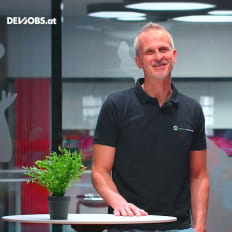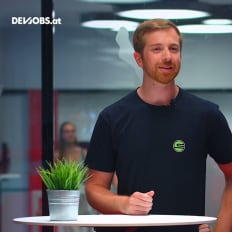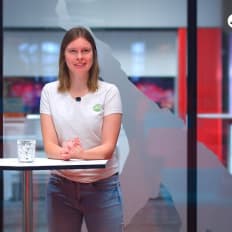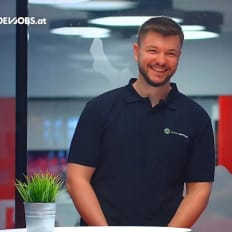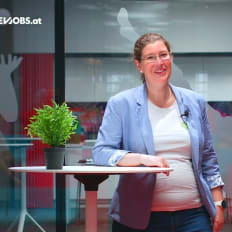
solvistas GmbH
Theo Crazzolara, Data Engineer bei solvistas
Description
Theo Crazzolara von solvistas gibt im Interview Einblicke in seine Anfänge mit dem Programmieren, was er täglich im Data Engineering zu tun hat und was seiner Meinung wichtig für Beginner ist.
By playing the video, you agree to data transfer to YouTube and acknowledge the privacy policy.
Video Summary
In 'Theo Crazzolara, Data Engineer bei solvistas', Speaker: Theo Crazzolara traces his path from school-time Python projects that turned photo and sports data into dashboards and mileage forecasts, through an industrial mathematics degree, to a full-time role at solvistas after volunteering, an internship, and part-time work. He outlines responsibilities spanning data engineering, data science, and business analysis across healthcare and finance, with a growing shift toward project management and multi-client support. His advice to developers: start small with simple automations and comprehensible example code, then raise expectations gradually.
From Photo Dashboards to Healthcare Data: The Journey of Theo Crazzolara, Data Engineer at solvistas GmbH
What this session covers
In “Theo Crazzolara, Data Engineer bei solvistas,” speaker Theo Crazzolara (solvistas GmbH) shares a straightforward, human-centered path into the world of data—starting with a self-written Python script in school and leading to multi-client work in healthcare today. At DevJobs.at, we listened to how curiosity (photos, sports, small predictions) grew into a profession with clear roles—Data Engineering, Data Science, and Business Analysis—through study, internships, and steady part-time work. The strength of this session lies in its practical steps, realistic expectations, and actionable advice for beginners.
“You take data and move it somewhere else… and check whether the data is okay.” That’s Theo’s concise definition of Data Engineering.
First contact with data: photos, likes, and running mileage
Theo’s story begins in school. He enjoyed photography—landscapes at first—and uploaded his photos. From there, he built a small data project: a Python script that downloaded view and like counts and turned them into a mini-report or mini-dashboard. This wasn’t just a toy; it set a pattern he repeated later: collect data, structure it, make it visible.
- Start with personal motivation (photography) and public metrics (views, likes)
- Build a basic script to fetch, process, and display data
- Turn raw numbers into a simple dashboard that surfaces insights
He soon extended the concept to his sports activities. Again, he gathered data, visualized it, and this time added a prediction: How many kilometers would he likely run over the year? For us, this is the pivotal early lesson: careers in data often begin with personal data stories. Small, relevant questions provide enough motivation to keep going and—almost incidentally—build the foundations of solid skills.
Choosing a data-focused degree: Technical/Industrial Mathematics
With the intention to “work with data,” Theo pursued Technical/Industrial Mathematics, focusing on finance and stochastics. The red thread remained: data, probabilities, models. While many career paths only pivot toward data later, Theo’s studies put measurable, data-driven problem-solving front and center from the start. The emphasis on finance and stochastics provided a durable base for data-informed decisions, which later shows in his project arc—starting in healthcare, then a half-year in finance, and back to healthcare afterward.
Early industry experience: from volunteering to part-time
Theo connected with solvistas GmbH in his second semester. It started with a volunteering stint to “see what the industry looks like” and “how to work with data at all.” That progressed to an internship and then a part-time position. Throughout his studies, Theo worked at solvistas—starting with 10 hours per week, rising to 20. After graduating, he moved into full-time work with 38.5 hours.
This sequence is a blueprint for how to blend learning with practice:
- Get an early look at real data processes (volunteering)
- Test yourself in a guided setting (internship)
- Build responsibility while studying (part-time)
- Transition smoothly into full-time work
From our perspective, this yields two major benefits: first, you encounter the actual constraints and rhythms of client projects; second, you develop domain depth over time—in Theo’s case, especially in healthcare.
Three roles in day-to-day data work: Engineering, Science, Business Analysis
Theo breaks his work into three complementary levels—Data Engineering, Data Science, and Business Analysis—that often overlap within projects.
Data Engineering: Move, process, and validate data
Theo frames Data Engineering as taking data and “moving it somewhere else.” This includes building a database where data is processed and checking whether the data is “okay.” It’s the backbone of the entire value chain: without reliable data flows, robust stores, and input quality, there’s no trustworthy reporting and no solid analysis.
Key points from Theo’s definition:
- Ingest and move data where it needs to go
- Set up processing paths and destination systems (e.g., a database)
- Validate and ensure data quality
Data Science: Compute metrics, visualize, and surface trends
For Theo, Data Science means working with the data to compute metrics, create graphics, and—through regular client conversations—show where the data is heading. That means turning hypotheses into metrics, making trends visible, and communicating outcomes in a way that aligns with both the technical and the domain context.
Core aspects:
- Define and compute meaningful measures
- Build visualizations
- Make developments transparent and discussable
Business Analysis: Interpret data and propose next steps
By working closely with data, you ��“also become good in the domain,” as Theo puts it. That leads to a Business Analyst role: interpreting data, explaining what it says, and giving feedback on the “next step” based on those results. The value of data becomes fully usable at this level—when domain insights translate into concrete actions.
Essential tasks:
- Explain the domain meaning of findings
- Derive relationships from the data
- Recommend subsequent steps to clients
Domain journey: healthcare, a finance stint, then back to healthcare
Starting part-time, Theo “slipped” into a healthcare project—the one that was available at the time. He built knowledge there and stayed for a long time. After graduating, he made a “detour” into a finance project for about half a year, aligning with his study focus, and then returned to the healthcare domain. Today, he supports multiple clients in that space.
We see a common and instructive pattern here:
- Many data careers begin opportunistically with whichever project is open
- Depth comes from time-on-task, not just theory
- Switching domains sharpens your profile while revealing where your strongest fit lies
Growing responsibility: project management born from practice
As experience grows, so does responsibility. Theo describes a progression “more toward project management,” especially when supporting multiple clients, aligning tasks, and deciding “who does what” and “who it fits best.” This shift is a natural outcome of:
- broader exposure across projects and roles
- deeper domain knowledge (particularly in healthcare)
- client trust built through regular discussions and actionable insights
Here, project management is not separate from technology—it emerges from a close relationship with the data: knowing which steps make sense when, and shaping reliable plans around that understanding.
Why variety across projects and roles keeps the work engaging
A theme that runs through Theo’s story is variety. Multiple projects, switching among Data Engineering, Data Science, and Business Analysis—this makes the work “always kind of exciting.” Depending on the client, you “take on a slightly different role,” and that has a personal effect: “It simply doesn’t get boring.”
For many developers and data professionals, that mix is essential: enough continuity to make an impact, and enough variety to stay curious. Theo’s path shows that career growth doesn’t only happen through titles; it happens through the number of perspectives you can reliably take on.
Advice for beginners: lower the bar, raise it later
Theo’s clearest advice is for anyone starting to program. Don’t set your sights too high when you’re trying things out yourself, he says, because if the initial bar is too high, “you become very quickly demoralized.” The alternative is to start deliberately small.
Concrete starting points Theo mentions:
- “Hello World”—the classic minimal entry
- simple automated graphics
- automating a download—there’s “a lot on the internet” about this already
Crucially, he emphasizes first understanding the existing code. Only once that is in place should you “raise your ambitions a bit” and aim to build something “that already exists,” but now under your own power and with your own understanding.
From an editorial vantage point, three principles stand out:
- Radically simplify the early stage
- Learn from working patterns, not in a vacuum
- Increase ambition once comprehension becomes routine
A step-by-step path into data practice
Using Theo’s path as a guide, here is a pragmatic, transcript-aligned route into data work:
- Find a personal hook: Pick something that genuinely matters to you (photos, sport, a hobby with measurable data). Motivation powers consistency.
- Start with the minimum: Write a tiny script that produces a visible result (e.g., download something or generate a simple plot).
- Make results visible: Assemble a mini-dashboard or mini-report. Visibility invites feedback and accelerates learning.
- Experiment with simple predictions: Try a small forecast, like Theo’s annual running mileage, to turn a hypothesis into something tangible.
- Seek early exposure: Use volunteering or internships to see real data processes.
- Grow responsibility gradually: Work part-time within a team, handle real client requests, and learn to hand off work reliably.
- Clarify the three roles: Practice the differences among moving data, computing insights, and interpreting results—and learn to shift between them.
- Build domain depth: Stay in one area long enough to develop genuine expertise—and take purposeful detours (like Theo’s finance project) to refine your profile.
- Communicate frequently: Regular check-ins with clients are core to Data Science. Results must be discussable and connected to next steps.
- Let coordination follow experience: As you gain trust and breadth, assigning tasks and guiding projects becomes the natural next move.
What Theo’s story teaches about data careers
- Curiosity plus small projects beat abstract ambitions. Theo’s photo dashboard is the archetype: tangible, useful, and motivating.
- A data-focused degree helps, but practice is decisive. Continuous work on real projects is the differentiator.
- Role clarity is a competitive edge. Understanding Data Engineering, Data Science, and Business Analysis makes you a bridge between tech and domain.
- Domain expertise creates stickiness. Long-term work in healthcare built depth, trust, and room to shape direction.
- Responsibility grows organically. Project management emerges from repeated, hands-on practice—not merely from a title.
Quotes and lines that stick
“That was my first small project… a mini-report, mini-dashboard.”
“I wanted to work with data.”
“Data Engineering… you take data and move it somewhere else… and check whether the data is okay.”
“Data Science… compute metrics, create graphics… show where the data is heading.”
“Business Analyst… become good in the domain… say what the data means… give feedback on the next step.”
“At the beginning… you just slip into some project.”
“Now… I support more clients… more toward project management.”
“It simply doesn’t get boring.”
“Don’t set your bar too high… otherwise you become quickly demoralized… first understand the code… then raise your ambition.”
Conclusion: A practical path powered by realistic expectations
“Theo Crazzolara, Data Engineer bei solvistas” is an invitation to shape your data journey pragmatically. A hobby (photos) becomes a small data project; a personal question (running mileage) becomes a prediction; early industry exposure leads to a role that blends multiple perspectives. The difference-maker isn’t a grand plan—it’s the accumulation of small, consistent steps: understand, make visible, discuss, improve.
Our biggest takeaway: with realistic expectations, a small start, and persistence, you can quickly build substance—technically, in the domain, and in communication. That’s the trajectory embodied by Theo Crazzolara at solvistas GmbH.
More Dev Stories
solvistas GmbH Jochen Falkner, Senior Data Scientist bei solvistas
Jochen Falkner von solvistas erzählt im Interview von seinem Weg in die IT, den Aufgaben als Senior Data Scientist und welche Ratschläge er Neueinsteigern mitgeben würde.
Watch nowsolvistas GmbH Fabian Weißenböck, Software Developer bei solvistas
Fabian Weißenböck von solvistas redet in seinem Interview über seine Anfänge mit dem Programmieren, was er aktuell in seiner Arbeit macht und was seiner Meinung nach wichtig für Beginner ist.
Watch nowsolvistas GmbH Markus Hiesmair, Software Engineer bei solvistas
Markus Hiesmair von solvistas erzählt im Interview über seinen Werdegang als Software Engineer – angefangen von der Schulzeit bis hin zur aktuellen Arbeit – und gibt Tipps für Neueinsteiger.
Watch nowsolvistas GmbH Michaela Raab, Data Scientist bei solvistas
Michaela Raab von solvistas gibt im Interview Einblicke in ihren Background, sowie ihren aktuellen Job als Data Scientist und gibt Tipps für Neueinsteiger.
Watch nowsolvistas GmbH Mateo Adzaga, UX Designer bei solvistas
Mateo Adzaga von solvistas redet im Interview über seine Tätigkeit als UX Designer, wie er damit begonnen hat und was er selbst gerne als Anfänger gewusst hätte.
Watch nowsolvistas GmbH Sophie Brückl, Product Owner bei solvistas
Sophie Brückl von solvistas teilt im Interview ihre Erfahrungen beim Wechsel vom Software Development hin zur aktuellen Arbeit als Product Owner und welche Tipps sie jenen gibt, die ähnliche Schritte planen.
Watch now

